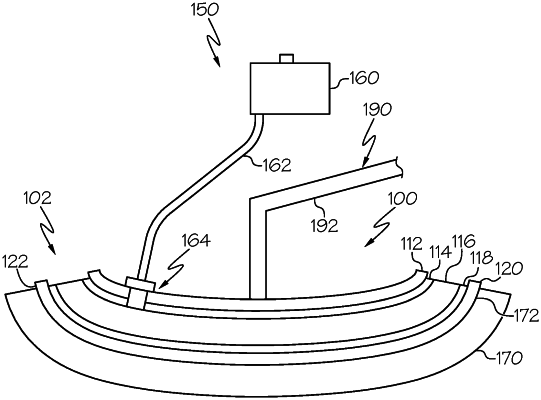| CPC B29C 70/443 (2013.01) [B25J 15/0616 (2013.01); B29C 43/12 (2013.01)] | 20 Claims |

|
1. A method for replicating a tool contour of a tool surface, the method comprising:
positioning a pliable structure relative to the tool surface of a tool, wherein:
the pliable structure comprises:
an internal volume formed by the plurality of sheet layers; and
a vacuum port in fluid communication with the internal volume;
each one of the plurality of sheet layers comprises an interior contact surface that is in full surface contact with the interior contact surface of a directly adjacent one of the plurality of sheet layers;
the exterior engagement surface is formed by one of the plurality of sheet layers and is opposite the interior contact surface of the one of the plurality of sheet layers; and
the exterior engagement surface has an initial engagement-surface contour that is different than the tool contour of the tool surface of the tool;
engaging an exterior engagement surface of the pliable structure with the tool surface of the tool such that the exterior engagement surface assumes a final engagement-surface contour that matches the tool contour of the tool surface, wherein, while engaging the exterior engagement surface with the tool surface, a plurality of sheet layers of the pliable structure are capable of slipping relative to each other;
with the exterior engagement surface engaged with the tool surface and having the final engagement-surface contour that matches the tool contour of the tool surface:
drawing a vacuum within the pliable structure;
increasing surface-to-surface friction between the plurality of sheet layers in response to drawing the vacuum such that shear slippage is substantially inhibited between the plurality of sheet layers by increasing surface-to-surface friction between the interior contact surface of at least one of the plurality of sheet layers and the interior contact surface of the directly adjacent one of the plurality of sheet layers of the pliable structure; and
locking positions of the plurality of sheet layers relative to each other in response to increasing the surface-to-surface friction; and
maintaining the exterior engagement surface of the pliable structure in the final engagement-surface contour after disengaging the exterior engagement surface from the tool surface via the surface-to-surface friction due to the vacuum.
|